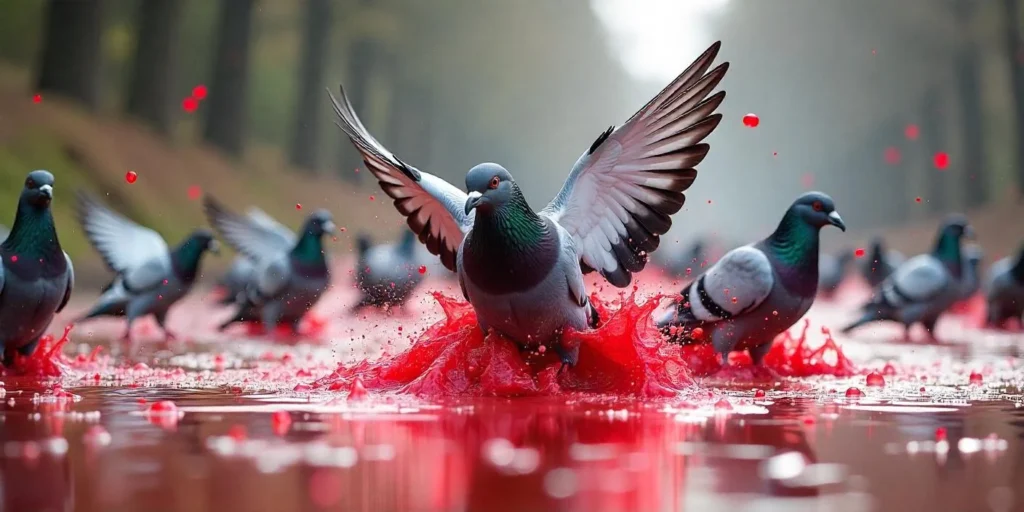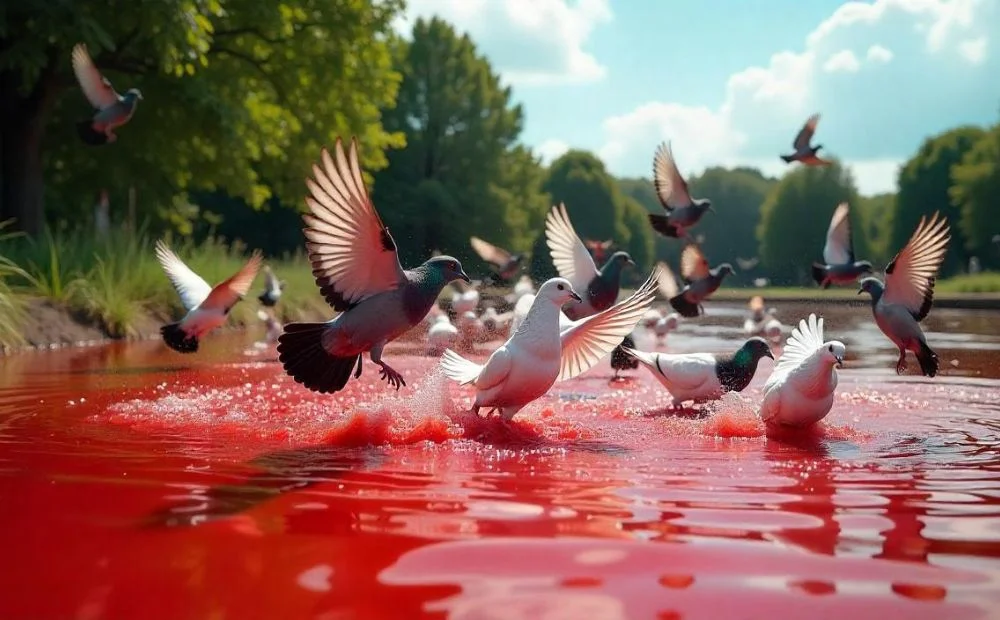Have you ever heard of 275 pigeons diving into a pond with red glue? If it sounds bizarre, that’s because it is. Imagine hundreds of pigeons, all diving together into a pond filled with an unusual red substance—glue, of all things! This phenomenon might seem straight out of a surreal storybook, but it’s attracting attention worldwide, leaving both scientists and bird lovers intrigued.
The idea of 275 pigeons diving into a pond filled with red glue raises many questions. Why would pigeons take this risky plunge, and what could be causing such behaviour? This article delves into the details behind this peculiar incident, examining theories, effects, and the broader implications for wildlife and human society.
The Scene of the Incident
Two hundred seventy-five pigeons dived into a pond filled with red glue. It sounds like an image from a nightmare, but it happened in a real place. The pond in a lesser-known rural town became a hotspot for this strange activity overnight. Locals were the first to witness the mass dive of pigeons, their wings flapping and dipping into a glue-covered pond dyed crimson. The visual of red glue spread across the water made the scene even more mysterious and somewhat disturbing.
What Could Have Drawn the Pigeons?
Why would 275 pigeons dive into a pond filled with red glue? Experts have been brainstorming a few possible theories. Birds are naturally attracted to water bodies, but something seemed to have gone awry in this case. The red colour could have been mistaken for food, or maybe the pigeons saw it as a safe resting area. Additionally, it’s possible that a chemical smell or a change in environmental signals misled the birds.
One leading theory suggests that the red glue might have looked like a natural water surface covered in algae or berries. Pigeons, whose vision is color-sensitive, may have mistaken the glue’s surface for an edible, berry-laden layer. This confusion likely played a significant role in causing 275 pigeons to dive into a pond filled with red glue.
Impact on Wildlife
The consequences of 275 pigeons diving into a pond filled with red glue were severe for the birds involved. Glue can pose significant dangers to a bird’s feathers, essential for flight. The pigeons that plunged into this red mess struggled to fly; their wings weighed down by the sticky substance. This meant an inability to escape predators, forage for food, or even return to their nests. Many of the pigeons needed immediate rescue, and unfortunately, not all survived the ordeal.
Wildlife conservationists rushed to the scene to help save the pigeons, using specialized cleansing agents to remove the glue from their feathers. This incident highlights how unnatural substances can drastically interfere with animal life, impacting ecosystems in ways we might not fully understand.
Potential Causes of the Red Glue Pond

The most perplexing aspect is why there was a pond filled with red glue in the first place. Investigation reveals that it could be the result of improper industrial waste disposal. The red glue might have been a byproduct from a nearby adhesive factory, carelessly discarded into an unused pond.
Another possibility is that a tanker transporting glue had an accidental spill. Either way, glue in a natural water source poses a massive environmental risk for birds and other animals that rely on the pond for drinking water.
Environmental Consequences of Such Incidents
The incident involving 275 pigeons diving into a pond filled with red glue isn’t just an isolated problem it’s emblematic of a more significant issue regarding human interference in natural ecosystems. Careless waste management, whether accidental or intentional, directly threatens wildlife. Pigeons, among many species, are sensitive to changes in their environment. The glue’s harmful properties have detrimental impacts, creating a chain reaction that ultimately affects biodiversity.
These consequences extend beyond just the immediate impact on the pigeons. The contamination of natural water sources also affects nearby plants and soil. Toxic substances leach into the ecosystem, affecting insect populations, vegetation growth, and even the health of local mammals. This episode of 275 pigeons diving into a pond filled with red glue underscores the importance of enforcing strict regulations for hazardous waste disposal.
The Role of Community in Protecting Nature
The event of 275 pigeons diving into a pond filled with red glue also highlights the role of communities in protecting local wildlife. In this case, local residents first raised the alarm and informed authorities. Their quick thinking led to timely intervention that saved many birds. Communities can be essential in monitoring and protecting natural spaces, especially in rural or less accessible regions.
Lessons Learned: Prevention for the Future
Incidents like 275 pigeons diving into a pond filled with red glue serve as a wake-up call for everyone. They illustrate how human activities, such as careless disposal of materials, can have immediate and devastating effects on local wildlife. Regulations must be more strictly enforced, especially concerning industrial waste.
Furthermore, awareness programs can help communities understand the consequences of environmental neglect. By educating people about how their actions might impact nature, we can help prevent future occurrences of similar disasters.
How to Help: Supporting Wildlife Conservation
If the story of 275 pigeons diving into a pond filled with red glue stirred something within you, you may wonder how to contribute to positive change. Supporting local and national wildlife organizations can go a long way in preventing and mitigating these incidents. Donations, volunteering, or simply spreading awareness about the impacts of pollution can make a difference. Every action counts when it comes to ensuring a safer environment for wildlife.
Additionally, consider advocating for better policies regarding waste disposal. This protects local birds and animals and safeguards natural resources for the community’s use.
The Curious Case: Nature vs. Human Influence
The incident of 275 pigeons diving into a pond filled with red glue reminds us how fragile the balance of nature can be and how easily human activities tip it. While this might sound like an unfortunate isolated incident, it stands as a powerful example of the far-reaching consequences of our actions. Glue in a pond might seem unusual, but the truth is that pollution, no matter the form, always finds a way to impact wildlife.
Like all other animals, birds are vulnerable to changes they don’t understand. The 275 pigeons diving into a pond filled with red glue are a prime example of nature’s innocence colliding with the hazards of human negligence. We must remember our essential role in safeguarding our environment—for ourselves and the animals who share it.
Conclusion
The sight of 275 pigeons diving into a pond filled with red glue is alarming and telling of our times. We cannot afford to let our negligence lead to the suffering of innocent wildlife. Proper waste disposal, stricter regulations, and community awareness can go a long way in preventing such incidents. Nature deserves our respect and protection, and by working together, we can ensure such bizarre and tragic events become a thing of the past.
The next time we hear of an unusual event like 275 pigeons, we dive into a pond filled with red glue and let it serve as a reminder of our duty toward the world we live in to act responsibly, to safeguard our surroundings, and to cherish all forms of life.





2 Comments